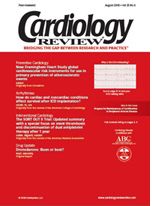Publication
Article
Cardiology Review® Online
Cardiac troponin as a biomarker for myocardial injury in heart failure
Cardiac troponin I (cTnI) and cardiac troponin T (cTnT) are cardiac-specific regulatory proteins that control the response of the contractile apparatus to calcium. The development of assays for cTnI and cTnT as biomarkers for myocardial necrosis has revolutionized the recognition of myocardial infarction because of their cardiac specificity and extraordinary sensitivity. The important study by Perna and colleagues (page 6) adds to the growing body of information indicating that cardiac troponin can also be used as a biomarker for ongoing myocardial injury in patients with systolic heart failure.
Perna and colleagues found that cTnT was elevated in more than half of apparently stable outpatients with advanced systolic heart failure. In general, the elevations of cTnT were mild, at just about the upper limit of normal. The presence of any abnormalities of cTnT and, even more so, persistent abnormalities of cTnT were strongly associated with a much poorer prognosis. The important implication of this study is that many patients with apparently stable systolic heart failure have ongoing myocardial injury and that it can be recognized using troponin as a biomarker.
Many of the patients in this study had coronary artery disease, and troponins remain elevated for several days following a myocardial infarction. Thus, it is possible that the increased troponin might be due to myocardial infarction. Elevated troponins were also found in patients with systolic heart failure without coronary disease, however. Thus, progressive deterioration and structural changes in patients with systolic heart failure may represent ongoing myocardial injury in addition to or as a consequence of neurohormonally mediated cardiac remodeling.
Perna and colleagues used cTnT, where other studies have used cTnI. Although cTnT and cTnI have not been directly compared in patients with heart failure, it is likely that they provide similar information.
The upper limit of normal for troponin assays is variable between assays and between institutions. Thus, the absolute value of cTnT greater than 0.02 ng/mL used as the threshold for ongoing injury in the study by Perna and colleagues will require careful reevaluation in each institution. It is important to recognize that results of the study were obtained using a third-generation cTnT assay. The results of the study may not apply to the earlier, less specific generations of cTnT assays.
The clinical implication of the study is that even minor elevations of troponin in patients with systolic heart failure indicate a poor prognosis, especially if the elevation is sustained over time. Thus, measurement of troponin may be useful in identifying high-risk patients. This points to the importance of investigating therapy efforts to diminish ongoing myocardial injury in these patients.
